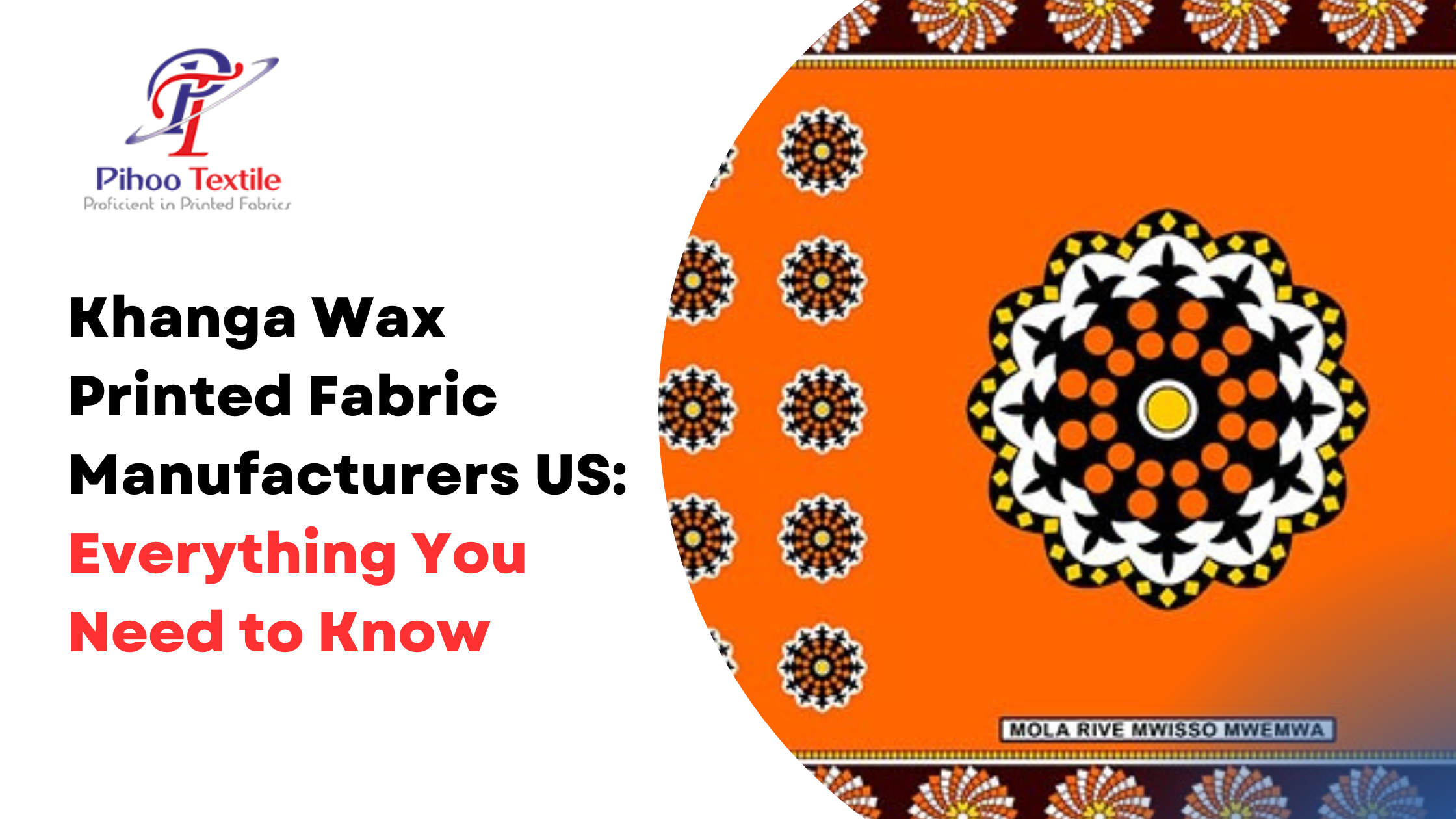Khanga Wax Printed Fabric Manufacturers US: Everything You Need to Know
The vibrant world of Khanga wax printed fabrics represents one of Africa’s most distinctive textile traditions that has found growing appreciation in the US market. As entrepreneurs look to diversify their textile offerings, understanding the intricate details of Khanga fabric manufacturing, sourcing, and market potential becomes essential for business success.
Introduction to Khanga Wax Printed Fabric
Khanga wax-printed fabrics stand as cultural ambassadors of African textile heritage, combining artistic expression with functional versatility. These rectangular cotton cloths, adorned with vibrant colors and meaningful designs, have transcended their African origins to become globally recognized textiles with significant commercial potential. In the United States, the growing appreciation for authentic cultural products has created promising opportunities for entrepreneurs entering this specialized market.
At the forefront of Khanga fabric manufacturing stands Pihoo Textile, one of the largest producers of African print fabrics. Established in 2018 and operating from a 25,000-square-foot facility in Jetpur, India, this manufacturer has developed substantial capability in producing high-quality Khanga fabrics specifically designed for African markets, with considerable export potential to the US. With a production capacity of 100,000 meters per day, Pihoo has positioned itself as a significant supplier in the global Khanga fabric trade.
Understanding Khanga Wax Printed Fabric
Khanga fabric is distinctively recognized by its rectangular shape, measuring approximately 150 centimeters in length and 110 centimeters in width. What truly distinguishes Khanga from other African textiles is its characteristic design structure consisting of a patterned border (pindo) surrounding a central motif (mji) and typically featuring a Swahili proverb or phrase (jina). These elements combine to create not just a piece of cloth, but a medium of communication and cultural expression.
The historical journey of Khanga textiles reveals fascinating cross-continental connections. From their early days, Kangas were predominantly produced in Europe and India, with British, American, Dutch, and Japanese imported cloth dominating the market throughout the 20th century. This changed in the 1970s when textile mills were established in Kenya, followed by Tanzania becoming one of the largest producers by 1985. Today’s production landscape has expanded significantly, with manufacturing centers in Kenya, Tanzania, Oman, India, Pakistan, and China – the latter now emerging as the largest producer globally.
The Manufacturing Process
The creation of Khanga wax printed fabrics involves a sophisticated process that combines traditional techniques with modern manufacturing technology. Pihoo Textile exemplifies this blend, utilizing advanced printing machinery while maintaining the aesthetic qualities that make Khanga fabrics culturally authentic.
The manufacturing process begins with high-quality cotton base fabric, which serves as the canvas for the intricate designs. Pihoo Textile’s production capabilities highlight the scale of modern Khanga manufacturing, with their facility housing state-of-the-art printing machinery capable of producing 100,000 meters of printed fabric daily. This impressive output is supported by specialized departments including testing laboratories and color matching units that ensure consistency and quality across production runs.
Environmental considerations have also become integral to modern Khanga production. Manufacturers like Pihoo emphasize their use of environmentally friendly dyes and printing processes, responding to growing consumer demand for sustainable textile production. This commitment to eco-friendly practices represents an important evolution in the industry that aligns with contemporary market expectations.
Quality Standards and Variations
Quality differentiation in Khanga fabrics primarily revolves around fabric weight, measured in GSM (Grams per Square Meter), and material composition. Premium Khanga fabrics typically feature 100% cotton construction with weights ranging from 80 GSM to 180 GSM. This spectrum allows for different applications and price points, with heavier fabrics generally commanding higher prices and offering greater durability.
Pihoo Textile’s offerings reflect this quality range, with their Khanga products spanning from lightweight 80 GSM pure cotton to more substantial 160 GSM cotton fabrics. This variety enables them to serve different market segments and price points while maintaining the essential characteristics that define authentic Khanga textiles.
Quality control processes are paramount in Khanga manufacturing. The inclusion of testing laboratories in production facilities allows manufacturers to verify color fastness, dimensional stability, and other critical quality parameters. These measures ensure that the finished products meet both technical specifications and aesthetic expectations – crucial factors for success in competitive textile markets.
Design Aspects
The visual language of Khanga fabrics speaks through a rich vocabulary of patterns and colors. Designs typically fall into categories including floral, fauna, and geometric patterns, executed in two or more vibrant, highly-saturated colors that create bold visual statements. The traditional three-part structure – border, central motif, and text – provides a framework within which enormous creative variation occurs.
What makes Khanga designs particularly significant is their cultural resonance. Far from being merely decorative, these patterns often carry symbolic meanings and references to cultural narratives. The inclusion of Swahili proverbs or phrases adds another dimension of communication, allowing the fabrics to convey messages ranging from social commentary to personal sentiments.
For manufacturers serving the US market, balancing authentic African design elements with contemporary American aesthetic preferences represents both a challenge and an opportunity. Understanding this cultural intersection is essential for entrepreneurs looking to position Khanga products successfully in the US retail landscape.
Market Dynamics
The US market for Khanga wax printed fabrics, while specialized, shows promising growth trajectory. Import data reveals that the United States received 9 shipments of wax printed fabrics during the period from September 2022 to August 2023, supplied by 4 foreign exporters to 4 US buyers. Notably, this represents a 29% growth rate compared to the preceding twelve months, indicating increasing demand despite the relatively small volume.
The supply chain predominantly features imports from India, China, and Thailand, with India leading as the top exporter of wax printed fabrics to the US market. This aligns with the global manufacturing landscape, where Indian producers like Pihoo Textile have established significant production capabilities specifically targeting export markets.
For entrepreneurs considering entry into this market, understanding these supply patterns and growth trends provides essential context. The relatively concentrated nature of the current import landscape – with just four buyers accounting for all shipments – suggests potential opportunity for new market entrants who can establish reliable supply relationships with international manufacturers.
Pihoo Textile’s Unique Offerings
Pihoo Textile exemplifies the capabilities of leading Khanga manufacturers serving global markets. Their product range encompasses multiple fabric weights (80-180 GSM), various size options (3.2 meter, 3.6 meter, and custom sizes), and thousands of design variations specifically created for South African markets.
What distinguishes Pihoo’s offerings is their commitment to quality fundamentals combined with flexible customization options. Their standard requirements – minimum orders of 4,000 meters per design with three-color combinations – reflect the production economics of specialized textile manufacturing while still allowing for custom designs that can help entrepreneurs differentiate their products in the US market.
The company’s emphasis on environmentally friendly color processes also aligns with growing consumer demand for sustainable production practices. This focus on both quality and sustainability creates a compelling value proposition for US-based entrepreneurs seeking manufacturing partners with comprehensive capabilities and contemporary values.
Challenges Facing Manufacturers
Entrepreneurs entering the Khanga fabric market face several significant challenges. The most immediate is the relatively high minimum order quantities required by manufacturers – Pihoo Textile’s 4,000-meter minimum for single designs represents a substantial inventory investment for small businesses. With pricing around 3,000 INR (approximately $36 USD) per meter, this translates to significant capital requirements for initial inventory.
Competition from established suppliers and fluctuating raw material costs present additional challenges. Cotton prices particularly affect production economics, with manufacturers increasingly exploring blended fabrics as alternatives to pure cotton to maintain competitive pricing. For US-based entrepreneurs, navigating these supply chain complexities requires careful planning and reliable manufacturing partnerships.
Import logistics and regulatory compliance add another layer of complexity. Customs procedures, tariff considerations, and transportation arrangements all factor into the total landed cost of imported textiles. Successfully managing these aspects is critical for maintaining competitive pricing in the US market.
Future Trends and Innovations
The future of Khanga wax printed fabrics in the US market appears promising, driven by several converging trends. The growing consumer interest in authentic cultural products, sustainable manufacturing, and unique textiles creates favorable conditions for market expansion. As global supply chains become more accessible to small and medium enterprises, opportunities for specialized textile importing continue to increase.
Material innovations represent an important direction for the industry. While traditional cotton remains the preferred base fabric, manufacturers are exploring alternative materials that can offer comparable aesthetics with improved performance characteristics or more competitive pricing. These innovations could expand the potential applications and market reach of Khanga-inspired textiles.
Digital technology is also transforming the industry, from design processes to supply chain management. Advanced digital printing capabilities enable smaller production runs with greater customization potential, potentially reducing the minimum order quantities that currently present barriers to market entry. For entrepreneurs, these technological developments could significantly reduce the capital requirements and inventory risks associated with Khanga fabric importing.
Conclusion
The market for Khanga wax printed fabrics in the United States represents a specialized but growing opportunity for entrepreneurs with appreciation for these culturally rich textiles. Understanding the manufacturing processes, quality variations, and market dynamics is essential for successful entry into this distinctive segment of the textile trade.
Pihoo Textile and similar manufacturers offer comprehensive production capabilities that can support US-based entrepreneurs in bringing authentic Khanga fabrics to American consumers. By navigating the challenges of minimum order quantities, quality control, and import logistics, forward-thinking business owners can establish viable operations in this unique market niche.
For those captivated by the vibrant colors and cultural significance of Khanga fabrics, the path from manufacturer to market involves careful planning but offers the reward of bringing these meaningful textiles to appreciative new audiences. As consumer interest in authentic cultural products continues to grow, Khanga wax printed fabrics stand poised to claim their place in the diverse tapestry of the American textile market.


